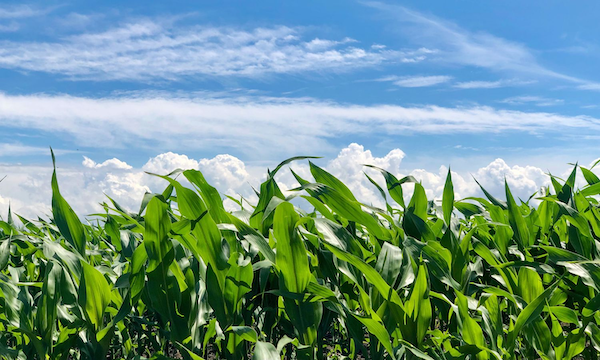At Gridline, we seek to provide interesting insights that aid in your investment decision-making alongside access to best-in-class fund managers. As we kick off the second quarter of the year, we want to update you on the trends we are currently seeing and highlight new features available on the Gridline platform.
We’re also honored to be selected as one of the “Top 10 Most Innovative Companies in Georgia” for 2024. This validation is core to our thesis that the antiquated and labor-intensive processes built by legacy service providers do not scale to 100,000+ financial advisers and millions of accredited investors looking to build better portfolios of alternatives. We have built a vertically integrated infrastructure by integrating sourcing, transacting, and custody while streamlining the investor journey of discovery, execution, and reporting.
We welcome your feedback and invite you to become a Gridline member today.
-Logan Henderson, CEO

Mechanism design, often hailed as ‘reverse game theory,’ finds significant application in the private markets. Read More
The term “emerging manager” can be misleading, often suggesting a manager that’s green, just starting out as an investor and relying on their first limited partners to take a risk on them while they build a track record. In reality, many emerging managers are quite the opposite. They are seasoned entrepreneurs and professional investors who’ve launched their own fund to capitalize on their unique sector ascendancy and have a long queue of investors who are justifiably eager to back them.
Capitol Meridian Partners (CMP) is one such fund. The team, led by industry veterans Brooke Coburn and Adam Palmer, recently announced the close of their first fund, raising $900M in capital, both exceeding the fundraising target and hitting the hard cap.
We participated in Capital Meridian Partners Fund I alongside more than 30 institutional investors, including endowments, foundations, pension funds, and others. We’d like to take a moment to congratulate the team at CMP and reflect on not only why we invested but also why we believe they’ve seen such great success in a challenging environment.
While many investors may be hesitant to invest in a first-time fund manager, these emerging managers are often the most successful at creating alpha for their LPs. It’s important to look beyond their emerging status and consider the team’s background, strategy, and philosophy. Congratulations again to the CMP team; we are excited to see what’s next.
-Logan Henderson, CEO
To view and download full details of the funds on our platform and in future emails like these, visit app.gridline.co/signup and answer a few quick questions that allow us to verify your identity and learn about your allocation strategy. There is no cost or commitment to create an account on Gridline.

GP Stakes investing offers unique advantages when it comes to yield, diversified exposure, and downside protection that set it apart from other private equity strategies. Read More
Chicago-based private markets investment firm Adams Street Partners recently released their 2024 Private Markets Outlook. A $58 billion asset manager, they surveyed pension funds, institutional accounts, and portfolio managers to determine their take on the year ahead. A few callouts:
While respondents were primarily large institutional investors, we believe individuals and advisors should be able to build portfolios that capitalize on these opportunities. Our investment team provides the curated selection of managers most likely to generate outsized returns and maintain resiliency across market cycles.
– The Team at Gridline
The outlook for private equity (PE) and venture capital (VC) sectors is heading towards a significant recovery, with predictions suggesting that fundraising will match the highs of 2021 by 2028. Despite the initial skepticism due to current macroeconomic and geopolitical climates, there are compelling reasons to believe in the feasibility of such growth.
Key to this optimistic forecast is the expected surge in nominal GDP, which the White House projects to be about 38% higher in 2028 than in 2021. This economic expansion lays a robust groundwork for the continued evolution and democratization of private markets, enabling the deployment of larger capital volumes more efficiently.
Additionally, the penetration of private investments into high-net-worth portfolios is anticipated to grow, with Bain forecasting a 12% annual increase in exposure to alternative investments. This shift reflects a broader acceptance and reliance on private markets for portfolio diversification and enhanced returns.
As we look towards 2028, the PE & VC sectors are poised not only to recover to their pre-pandemic levels but also to capitalize on the growing investor confidence in private markets. Integrating alternative assets into investment strategies is becoming increasingly mainstream and underscores the significant potential for growth and transformation in the private markets over the coming years.
-Logan Henderson, CEO
To view and download full details of the funds on our platform and in future emails like these, visit app.gridline.co/signup and answer a few quick questions that allow us to verify your identity and learn about your allocation strategy. There is no cost or commitment to create an account on Gridline.

In our most recent blog by Gridline investment team member Charles Patton, we explore the history and future opportunities of cybersecurity. Read More.
A fresh year brings a chance to step back and consider how the investing landscape might shift in 2024. One reliable source for clues on the year ahead is the annual reports by economists and professionals at investment houses throughout the country. While we find all their reports useful, oftentimes, the best insights come from understanding what’s just occurred in more detail.
To that end, we’ve read through annual outlooks from Preqin (abridged), Apollo, KKR, and Cambridge Associates. We’ve selected our favorite chart from each, alongside an explanation of why it influenced our thinking. The common thread across buyout, venture, private credit, and real assets is an expectation that 2024 hews closer to the mean than the extremes of the past several years.
We look forward to bringing similar insights across asset classes at a quarterly clip to highlight interesting insights we find across the private markets ecosystem and welcome your feedback as 2024 awaits.
-Logan Henderson, CEO
To view and download full details of the funds on our platform and in future emails like these, visit app.gridline.co/signup and answer a few quick questions that allow us to verify your identity and learn about your allocation strategy. There is no cost or commitment to create an account on Gridline.

The demand for private credit strategies is growing, and it’s vital to understand how investments in private credit are positioned. Read more.
Fortune journalist, Jessica Mathews, featured a prediction from Logan in the 2024 Crystal Ball edition of Term Sheet last week.
The week-long series features 2024 predictions and potential shifts and shake-ups in the private markets according to investors and founders across the technology and capital ecosystem.
Logan’s perspective underscores the importance of integrity and transparency in the evolving landscape of private market investing.
– The Team at Gridline
I spoke on a panel at a wealth manager conference last week and the moderator asked me what the greatest opportunity for investors will be as we look ahead to 2024.
My answer was venture capital.
It might be the only time investing in venture capital came up at the conference. It’s been well documented that the over-exuberance of 2018 through 2021 flooded the ecosystem and drove outrageous evaluations. You’re seeing the fallout continue to drive headlines that imply venture is declining as an asset class. More markdowns are still to come, but that’s money that’s already been put to work.
Entry valuations are becoming much more attractive versus the past several years. Funds that were deploying aggressively in the low-rate environment, especially into later-stage ventures, will continue to see markdowns in their portfolios. However, capital being deployed now and in the near future is being put to work in a rationalized market with right-sized valuations, which we believe will drive outsized returns for investors in current fund vintages.
Many of the strongest performers in the asset class have been emerging fund managers with a differentiated strategy and sector specialization. They are experienced in their industry, with standout investing experience at a more established manager or operational experience working in the space. These are often not large name-brand funds, and they are not the kind of funds available on legacy investment platforms like CAIS and iCapital.
We believe a portfolio that includes both large established funds and these smaller managers with a unique edge carries the highest probability of achieving top-quartile returns.
-Logan Henderson, Founder and CEO
To view and download full details of the funds on our platform and in future emails like these, visit app.gridline.co/signup and answer a few quick questions that allow us to verify your identity and learn about your allocation strategy. There is no cost or commitment to create an account on Gridline.

Walk through a practical example of how harvesting losses today can pay dividends for years to come. Read more.
We’re excited to announce the new Fund Activity view is now available in Gridline.
Members now have the ability to dive deeper into their Gridline investments and see the companies that their dollars are invested in. They can also toggle to see the portfolio companies for all Gridline products, many of which are still marked as open for investing.
Each company has a quick link to the company’s website, an industry or sector description, and which fund has invested in the company and at what stage.
This feature is just one more way we’re bringing an unparalleled level of performance detail & transparency to private market investing.
– Peter Bilali, VP Product
Barron’s recently published an opinion piece by Catherine Keating, global head of BNY Mellon Wealth Management. In the article, she once again makes the case that individuals should be investing like institutions – a point we’ve made many times ourselves, and one of the key reasons we founded Gridline.
The decline in listed publicly traded companies, the length of time companies are staying private, and bank reforms on lending all underscore the importance of increasing allocations to alternatives for generating returns and accumulating wealth.
The other characteristic that gives a leg up to institutional investors? Emotion…or lack thereof. Keating argues that just as institutions invest according to their investment policy statement (IPS), individual investors should do the same. Set your allocation targets, invest accordingly until you hit them, and then maintain for the long-term.
In essence, an investment policy acts as a roadmap for investing, providing a structured approach that reduces the influence of emotions. We are well aware that personal finances and wealth are deeply intertwined with our sense of identity, making them among the most emotionally charged aspects of our lives. Stay informed but not emotionally reactive. Engage in informed research about market trends, economic developments, and your investment portfolio, but avoid making impulsive decisions based on fear or panic.
It’s crucial to remember that time in the market is often more important than timing the market!
By focusing on long-term goals and rational decision-making, an investment policy helps investors make sound investment choices and achieve their financial objectives over the long term.
As Keating states, there is much work to be done by both wealth managers and the alternatives industry to make these types of investments available to more investors. We think we’re contributing, building a platform that brings both transparency and efficiency to private market investing.
-Logan Henderson, Founder and CEO

If you or anyone in your network are in the New York area, we invite you to join us for casual networking and a walking tour of Central Park hosted by our own Greg Kaufmann, who served as a volunteer tour guide for the Central Park Conservancy for 10 years. Learn about the park’s history, ecology, geology, and design, while networking between stops.
To view and download full details of the funds on our platform and in future emails like these, visit app.gridline.co/signup and answer a few quick questions that allow us to verify your identity and learn about your allocation strategy. There is no cost or commitment to create an account on Gridline.

Explore the rising ESG focus in private equity, with a record $3.7 trillion in dry powder in 2022 and investors seeking ESG-aligned firms for better returns and sustainability. Read more.

AcreTrader announces another successful disposition with the sale of four farm offerings aggregated together for an average performance above underwrite of 25%. Read more.
It’s no secret that the S&P500 has been on a tear through 2023, shrugging off higher rates and geopolitical concerns and posting a 15.5% return at yesterday’s market close.
That bull market has been disproportionately powered by seven technology companies (Apple, Microsoft, Amazon, Nvidia, Alphabet, Tesla, and Meta), which were up over 50% from January 1st through late September and now comprise over a quarter of the S&P.
Many of those companies are richly valued, including Nvidia’s eye-catching 187x price-to-earnings ratio. When BlackRock examined the S&P500’s aggregate P/E with and without the seven giants as of June 30 this year, it swung from 20.4x to 17.5x, much closer to long-term averages.
While it’s certainly possible that those outperforming names will continue their hot streak, studies suggest that P/E ratios for individual stocks tend to revert to the mean over time, so large run-ups in P/E ratios are often followed by pullbacks. That would mean putting up the same type of performance we’ve seen through 2023 thus far, many of these names would need to more than double their earnings in a short span.
What does this mean for investors?
The run-up has decreased the diversification investors receive from many index funds because those high multiple mega-caps now comprise a larger portion of the index, forcing index providers to change their weightings to ensure some diversification.
Now is an opportune time for investors to consider greater diversification than indices currently provide by allocating a portion of their portfolios to the private markets, where valuations have become more attractive rather than less over the course of 2023.
Finally, before we close, I want to acknowledge, on behalf of everyone here at Gridline, the unfolding tragedy in and around Israel at this time. Our hearts are heavy with concern, and we hope for the safety of our friends and colleagues in the region.
-Logan Henderson, Founder and CEO
To view and download full details of the funds on our platform and in future newsletters like these, visit app.gridline.co/signup and answer a few quick questions that allow us to verify your identity and learn about your allocation strategy. There is no cost or commitment to create an account on Gridline.

This often overlooked strategy has gained traction in recent years and offers unique advantages for those seeking exposure to the private markets. Read more.

Buyout firms own more than 10,000 US companies, more than double the number of domestic US-exchange-listed public companies. Read more.
Later this year, we will open up access to a new portfolio allocation simulator within the Gridline platform.
This will allow investors to easily build an allocation pacing model across alternatives and public assets. Through this simulator, investors can understand how to build a self-funding portfolio & generate superior returns.
If you are interested in receiving early adopter access to this feature, please let us know by replying to this email so that we can grant your account access. As always, we appreciate your feedback on any other features or platform experiences as well.
– Peter Bilali, VP Product
This week we sat down with Phil Herget and Phil Bronner of Ardent Venture Partners. Ardent is a DC-based, early-stage venture firm and an investor in Gridline.
Sixteen months ago, Phil Herget published a widely shared Medium article on lessons learned from venture investing during the financial crises of 2001 and 2008.
Now that we appear to be in the wake of the most glaring market corrections, we wanted to look back at some of these predictions and the road ahead. A few key takeaways:
We are starting to see the green shoots of even large institutions refocusing on emerging venture managers this week with CalSTRS, the $321 billion pension plan, reaffirming its commitment to emerging managers through a partnership with Sapphire Partners.
Whether individuals are managing their investments independently or relying on wealth managers, it’s doubtful that they are maximizing their investment potential via a limited set of opportunities. At Gridline our focus is helping investors build diversified portfolios of active managers across both emerging managers and larger players.
-Logan Henderson, Founder and CEO
To view and download full details of the funds on our platform and in future emails like these, visit app.gridline.co/signup and answer a few quick questions that allow us to verify your identity and learn about your allocation strategy. There is no cost or commitment to create an account on Gridline.

The mechanisms used align the interests of the GPs and LPs, leading to mutually beneficial outcomes. Read more.
Gridline is excited to announce our approval as a member of The Depository Trust & Clearing Corporation (DTCC) Alternative Investment Products (AIP) suite of services.
Traditionally, reporting on alternative investments relied on manual methods like hardcopies, emails, phone calls, and spreadsheets, leading to error-prone processes and hampering industry growth.
By standardizing the industry’s communication standards, AIP seamlessly connects fund managers, administrators, and custodians through automated trade order initiation, settlement, and post-trade reporting, boosting efficiency, reducing risks and lowering costs.
Membership to the AIP is another evolution of Gridline’s mission to enable a more efficient and scalable alternative investment industry.
We have discussed the level of uncertainty in public equity markets, but there are a few fundamental changes that are exacerbating this uncertainty. The impact of market concentration is increasing volatility, and rising inflation is causing investors to reconsider their approach and look beyond the public markets.
In 1996, over 8,000 companies were publicly traded in the US, but by 2022, this number fell to under 4,200, yielding a ~50% reduction in investment opportunities. This, in turn, created greater concentration, with the S&P 500 accounting for roughly 80% of the total US equity market capitalization and, even more concerning, the five largest companies representing 24.2% of the index’s total market cap.
Additionally, the resurgence of inflation has further complicated the investment landscape. Public equities, which have long been viewed as a hedge against inflation, have shown vulnerabilities during periods of rising prices, making it more difficult for investors to achieve positive real returns.
One way to address these complex challenges is to invest in a carefully constructed portfolio of alternative assets. These assets, which include private equity, venture capital, private debt, and real assets, can help to protect investors from market vulnerabilities while generating compelling returns. When built well, these portfolios can deliver returns in excess of public markets, generate those returns with lower volatility, protect against inflation (or benefit in the case of assets like farmland), and expand the universe of investable options.
While the idea of an alternative portfolio is appealing, its implementation is hindered by challenges. Private market access is limited, and there are no private-market index funds, requiring investors to construct their own diversified portfolios. Return dispersion is significant, making manager selection a critical function. Lastly, the dynamics of capital commitments, calls, and distributions require active cash flow modeling and management.
Gridline has developed solutions to overcome these challenges, enabling investments in well-constructed portfolios of best-in-class managers and providing easier management of cash flows and performance. We partner with our members to deliver more robust and resilient investment outcomes, and I’d recommend you join our webinar at 1p ET this afternoon to learn more about the market and our approach.
-Logan Henderson, Founder and CEO
Join us today at 1:00 pm ET to discuss how you can expand your portfolio to include diverse asset classes and under-the-radar managers through simple-to-execute strategies. During the session, you’ll hear about:
We hope you’ll join us, but if you can’t attend live, register, and we’ll share the recording with you after the session.
To view and download full details of the funds on our platform and in future emails like these, visit app.gridline.co/signup and answer a few quick questions that allow us to verify your identity and learn about your allocation strategy. There is no cost or commitment to create an account on Gridline.

Emerging fund managers have some inherent advantages over established managers that lead to outperformance. Read more.
Navigating a volatile market can be difficult. The level of uncertainty related to inflation, rising interest rates, high private asset valuations and geopolitical risk are putting markets under significant pressure.
Most people think about downside protection by moving investment portfolios into cash. But cash holdings make close to no interest and they lose purchasing power when prices rise during inflationary periods. One dollar buys less than before, leading to negative returns.
You may have heard the term “buying the dip,” which refers to how increasing volatility becomes an opportunity to acquire assets at a lower price. Market downturns that result in mark-to-market losses present an opportunity to buy cheaper assets that profit when the market rebounds.
The conventional wisdom was that private markets follow public markets with a six-month lag. This trend is accelerating with transactions that were closing at a billion dollars a few months ago now often closing at half the value.
A high valuation is great for the company that closed the transaction, but it now has a lofty valuation to grow into during potentially difficult markets.
If you could invest in the same company at half the price, would you?
Investors deploying capital now are entering the investment at a compressed valuation that lowers the cost basis, which may provide the same or better returns with lower hurdles, commonly referred to as the goal posts. A 3x return on a $500 million investment looks very different from a 3x return on a $1 billion or greater investment.
Having a sound investing strategy and allocation plan allows you to select the right asset class to enter when volatility is introduced, and prudent investment behavior and a long-term outlook are key to the preservation and growth of your investment portfolio in all market cycles.
Sound investing requires a long-term strategy, and Warren Buffett has a great perspective for how you should view your portfolio.
“It’s exactly the same way as if you are going to buy a farm,” he said. “You would not get a price on it every day and you wouldn’t ask whether the yield was a little above expectations this year or down a little bit. You’d look at what the farm was going to produce over time.”
Alternative investments take this long-term approach to heart. Just look at the dot-com crash of the early 2000s. In the decade following that period, the public market equivalent index’s annual return fell to 0.08% while private equity maintained a robust 7.5% average.
Alternatives offer two great benefits to counter the movements in the public market:
Many investors — especially those in the “Next-Gen Wealth” category — are overwhelmingly steering their individual portfolios toward alternative investments in order to stave off the volatility of inflation, rising interest rates and geopolitical uncertainty.
Deploying capital with active fund managers in the private markets is the best way to realize these outsized returns and offers a greater chance of exposure to breakthrough companies (sometimes referred to as “capturing private market alpha”), while providing diversification across geographies, sectors, business models and theses.
Experienced fund managers not only are great at selecting companies to invest in, but the true value comes from everything that happens with the portfolio after the initial investment. This includes board work, hiring strong teams, allocating capital in follow-on rounds and working to get exits.